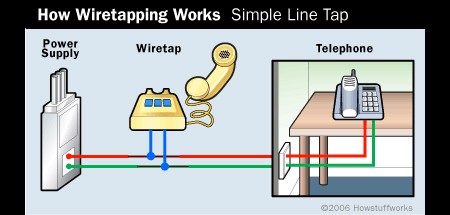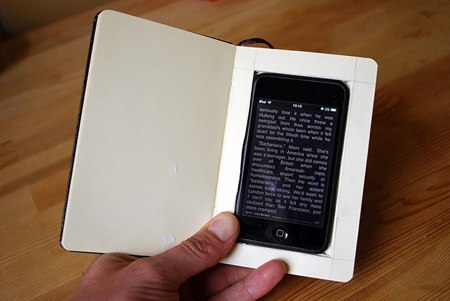
Nokia recently announced its plans to purchase Symbian and formed the Symbian Foundation with the intention opening the software platform over the next two years. Symbian is already present on 60% of all cellphones in the world. With such a massive install base, open source Symbian has a much better chance of taking off than platforms like Android, which are starting on the ground floor.
Cellphone Hacks537 Articles
Wiretapping And How To Avoid It

No matter who you suspect is plotting your doom, you’ll need need to know the way wiretapping works in order to learn their plans and shield yourself from their surveillance. Luckily, ITSecurity has posted a comprehensive
article about wiretapping, including information on how to wiretap and how to find out if someone is wiretapping you.
One of the more intriguing methods of wiretapping the articles discusses is a service by a company called FlexiSPY. It works by covertly installing a program onto the target’s cellphone. Once installed, the spying party can listen to anything going on in the room the target is in by calling the phone. It won’t ring, vibrate, or give any indication that it is transmitting audio data.
Some of the more hack-oriented methods involve tapping into a landline, using special software to record VoIP calls, or buying a wiretapping kit. Of course, countermeasures, are also discussed, but some of the links they provide are a little more informative on the topic of defense against wiretapping.
IPhone Used To Control Squad Of UAVs
[youtube=http://www.youtube.com/watch?v=CRcld5aAN2E&hl=en]
Building UAVs is only half the work involved in making them fly; the other half is a control system. The Center for Collaborative Control of Unmanned Vehicles (C3UV) from the University of Califorina, Berkeley has devised a way to control a squad of RC airplanes with an iPhone. The system works by submitting commands and coordinates to a web site via the iPhone’s web browser. The site then sends the commands to the team of drones, which carry out the orders. The drones are outfitted with cameras and a tracking device, which allows them to be monitored on the ground using Google Maps.
The iPhone Terms of Service specifically prohibits it being used to drive remote vehicles, but that shouldn’t really pose a problem: since the orders are deployed via the iPhone’s web browser, they could technically be given by any web-enabled device. Before anyone cries foul, though, bear in mind that the idea is to issue orders from the field, and the iPhone is perhaps the most high-profile mobile web device on the market, which maximizes the project’s exposure. Still, we can’t help but think that they’d have gotten more media attention if they had used a hacked Kindle instead.
Nokia Color LCD Flickr Frame

Tinkerlog got their hands on a color LCD from SparkFun and set it up to receive images from Flickr. These color LCDs are 128×128 pixel and the include a breakout board with a separate power supply for the backlight. Communication is via a three wire SPI bus plus a reset line. [Alex] used an ATmega48 for control, which is connected to the computer using an RS232 to USB converter. The wiring schematic is here.
For the software side of things, he adapted Sparkfun’s example ATmega8 code for the microcontroller (he couldn’t get the Arduino code to work). Beej’s Python Flickr API was used to grab the images. The Python Imaging Library converted them, and finally, they were sent to the display using pySerial. SparkFun has been offering these displays for quite some time; it’s good to see a quality writeup of one in use.
[via Make Flickr Pool]
Ultraportable Laser Graffiti?
[Sittiphol Phanvilai]’s multitouch screen project was posted a couple different places today. It uses the Nokia N95 to track light pens and draws the resulting paths on the video output. We immediately saw the applications for this in laser tagging. Right now if you want to do laser tagging you need to haul a laptop with you in addition to the projector. With some modification to the NeuScreen software you could replace the laptop with just cellphone plugged directly into the projector.
Nokia 1100 LCD PIC Controller Interface

Nokia LCDs have been a popular choice for hardware projects for quite a while. [Ramandeep] published a how-to on interfacing the 1100 series LCD with a PIC controller. The 1100 features easily soldered contacts and a backlight, making it an good choice for adding an LCD to your project.
Covert IPhone Moleskine Case

Crafting isn’t really our thing, but just last week we were planning on doing this project. Thanks to the how-to singularity: the longer we wait, the more likely someone else will do our dirty work. The instructions are this:
- Cut a hole in a book.
- Stick your phone in that book.
- Let her open the book.
Wired’s write up has about 600 more words if you need clarification. The ebook on the screen is Cory Doctorow’s Little Brother, so expect to see this on BoingBoing… and again when it’s fan translated into Polish. [bre] made a similar hidden compartment book last Fall for Make’s PDFcast.
In all seriousness, we do enjoy the idea of carrying an innocuous little book around that could be doing some covert WiFi scanning, acting as a mobile accesspoint, or live streaming our location to friends. Unfortunately, since it’s an iPhone, most of this isn’t possible yet; you can’t even voice dial from your headset, while leaving the notebook in your pocket. This case also blurs what is considered rude. Most people would be annoyed if you started txting mid conversation, but people taking notes in Moleskines don’t get the same treatment.









